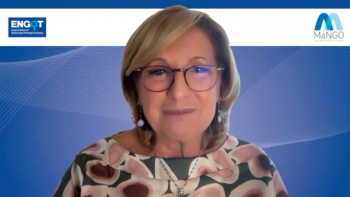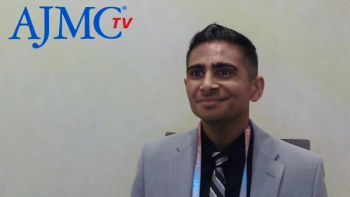
Zeroing in on Sarcoma Subtypes to Optimize Treatment Outcomes
The field of sarcoma study is getting more specific, with clinical investigations drilling down to more specific subtypes of soft tissue sarcoma for better targeted therapies.
Our discussion with Ravin Ratan, MD, MEd, associate professor, Department of Sarcoma Medical Oncology, Division of Cancer Medicine, The University of Texas MD Anderson Cancer Center, continues as he discusses where research is heading to refine treatment for specific sarcoma subtypes.
You can see previous segments from this interview on our
Transcript
What are some current research priorities in STS, and can you highlight any challenges or recent advancements in the field?
I think there's a few different trends. We talked a little bit about
Now instead of seeing drugs that are approved for all soft tissue sarcoma, you're much more likely to see new therapies that are approved in specific sarcoma subtypes. Tenosynovial giant cell tumor, desmoid tumors, technically aren't a sarcoma, but they are a connective tissue cancer that had a recent approval last year.1 Alveolar soft part sarcoma recently had an immunotherapy drug, atezolizumab, that was approved specifically for use in that disease.2 You're seeing approvals in specific subtypes of populations of sarcoma, which hopefully means that these are actually groups that are more likely to benefit from the treatment as opposed to just sort of approving it for all soft tissue sarcoma and recognizing that it’s heterogeneous and there are some patients that we predict might not benefit from the treatment.
So I think one change that we're seeing, and one priority, is really trying to zero in on subtypes of sarcoma as opposed to just treating soft tissue sarcoma as a single disease.
Other areas of priority beyond immunotherapy, which, of course, is still a big one—we're really trying to get that to work because the promise is that ideally we’ll start to see some longer responses—is using other classical chemotherapy, so cytotoxic chemotherapy, in combination with things like anti-angiogenic agents like cabozantinib, pazopanib, or immunotherapy, and actually trying to get real synergy, not just taking 2 drugs together or giving them at the same time and demonstrating that the 2 drugs work together work as well as drug A plus drug B. Actually trying to show that you can actually enhance the response, get real synergy; the 2 drugs work together better than either drug will work on its own sequentially. And I think we’ve started to see hints of things like that with combinations like doxorubicin-trabectedin, which was the subject of a phase 3 randomized study by the French Sarcoma Group last year in leiomyosarcoma, and showed some really impressive results over doxorubicin alone.3
There's other signals that a cousin of trabectedin, lurbinectedin, may have some synergistic interactions with doxorubicin as well; that was a very small phase 1 study that was presented at ASCO last year.4 We'll see where that goes. But I think really trying to demonstrate synergy with the drugs that we already have out there is sort of another area of interest. A lot of the studies presented in our meetings in the last year or 2 were combinations of things like anti-angiogenic agent plus chemotherapy, for example.
And then I sort of talked about this earlier, but defining new diseases based on molecular techniques that worked as widely available 10 years ago and then trying to understand how those newly defined entities respond to treatments that we've had and treatments that we're developing. An example would be, there was a whole group of diseases that were called Ewing-like sarcomas. They were tumors that looked like Ewing sarcoma under the microscope, but they didn't have the characteristic genetic change that Ewing sarcoma had. We just call them translocation negative viewings, and we've treated them like Ewing sarcoma forever. And what we've seen in the last 5 or 6 years is, in fact, those tumors have other genetic changes that we can now find using next-generation sequencing and so forth.
We're sort of defining new slices of that pie that are different diseases, and so even though we've always treated the same, they don't respond to Ewing chemotherapy the same way that Ewing does. And their prognosis is quite different. The patients who get them are different. Take one example, CIC-DUX4 sarcoma, where the patients are older, it's usually a soft tissue tumor instead of a bone tumor, and the response rates to Ewing sarcoma–like therapy are much poorer than they are in Ewing sarcoma in the frontline. And then nothing that we use second or third line for Ewing sarcoma works in this disease real well. So totally different disease, different prognosis, but now we've described that the next step is trying to figure out, well, if that doesn't work, what are we going to do instead? I think that's sort of where there's some interest now.
References
1. Turalio new dosing regimen now available in the U.S. for certain patients with tenosynovial giant cell tumor. News release. Daiichi-Sankyo. February 1, 2023. Accessed June 27, 2024. https://daiichisankyo.us/press-releases/-/article/turalio-new-dosing-regimen-now-available-in-the-u-s-for-certain-patients-with-tenosynovial-giant-cell-tumor
2. FDA grants approval to atezolizumab for alveolar soft part sarcoma. News release. FDA. December 9, 2023. Accessed June 27, 2024.
3. Pautier P, Italiano A, Piperno-Neumann S, et al; French Sarcoma Group. Doxorubicin alone versus doxorubicin with trabectedin followed by trabectedin alone as first-line therapy for metastatic or unresectable leiomyosarcoma (LMS-04): a randomised, multicentre, open-label phase 3 trial. Lancet Oncol. 2022;23(8):1044-1054. doi:10.1016/S1470-2045(22)00380-1
4. PharmaMar announces abstracts to be presented at ASCO 2023. News release. PharmaMar. May 26, 2023. Accessed June 27, 2024.
Newsletter
Stay ahead of policy, cost, and value—subscribe to AJMC for expert insights at the intersection of clinical care and health economics.















































